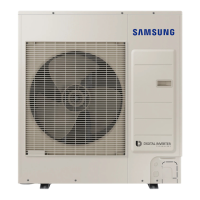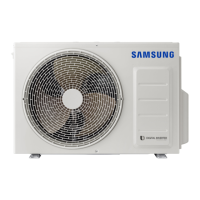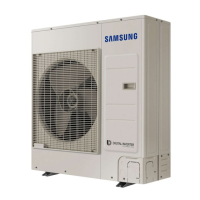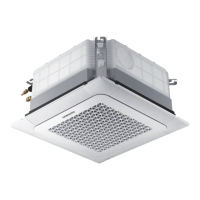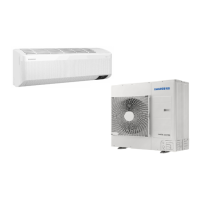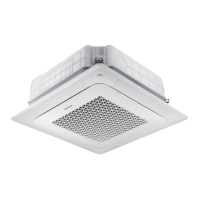17
English
Installation Procedure
Step 5 Connecting the refrigerant pipe
Items
Outdoor unit
models
Main pipe
(L1)
Max. height difference
between outdoor and
indoor units (h1)
Maximum
allowable
length
AC052TXADKC 30 20
AC071TXADKC 50 30
AC100TXAD*C 50 30
AC120TXAD*C 75 30
AC140TXAD*C 75 30
AC160TXAD*C 75 30
n=1
Outdoor
L1
h1
Indoor Unit
indoor
• Temper grade and minimum thickness of the refrigerant pipe
Outer diameter
[mm]
Minimum thickness
[mm]
Temper grade
ø 6.35 0.7
C1220T-O
ø 9.52 0.7
ø 12.70 0.8
ø 15.88 1.0
ø 15.88 0.8
C1220T-1/2H OR
C1220T-H
ø 19.05 0.9
ø 22.23 0.9
CAUTION
• Be sure to use C1220T-1/2H (Semi-hard) pipe for more
than Ø19.05 mm. If you use C1220T-O (Soft) pipe for Ø19.05
mm, the pipe may be broken, which can result in an injury.
Block the part.
A
Make at least one round:
It will reduce noise and vibration
• The appearance of the unit may be different from the
diagram depending on the model.
CAUTION
Pipe outlet
• Cut the pipe outlet to the exact pipe size. In addition,
remove foreign substances and burrs around the outlet.
• ťʪθ˙ͱθʀЇϩϩ˝иϩ˵ͱцɇʀЇϩϩʪθ࣑ʪуΧΧʪθ࣒ɇʒ
never tap with a hammer near the pipe outlet.
Otherwise, it may cause product damage such as
warping of the cabinet.
• After connecting the pipes with pipe outlet, plug the
space around the pipes.
• After connecting the pipes, proceed exactly as directed in
the guide to prevent interference with the internal parts.
• Tighten the nuts to the specified torques. If overtightened,
the nuts could be broken so refrigerant may leak.
• Protect or enclose refrigerant tubing to avoid
mechanical damage.
• After installing pipes, block the unused knock hole
to prevent small animal from entering. However, the
radiant heat hole(A) should be able to intake air.
Step 6 Optional: Cutting and flaring
the pipes
1 Make sure that you have the required tools available.
࣑ΧΧʪʀЇϩϩʪθࡥθʪɇʪθࡥѤɇθ˝ϩͱͱࡥɇʒΧΧʪ˵ͱʒʪθ࣒
2 If you wish to shorten the pipes, cut it with a pipe
cutter, taking care to ensure that the cut edge remains
at a 90° angle with the side of the pipe. Refer to the
illustrations below for examples of edges cut correctly
and incorrectly.
Pipe cutter
90°
Pipe Oblique Rough Burr
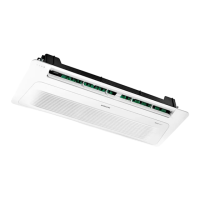
